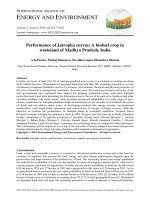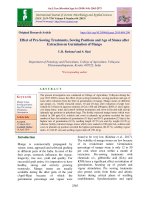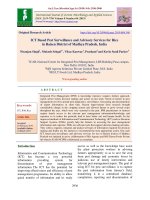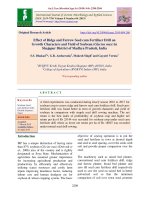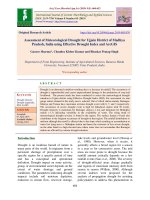Effect of raised bed sowing of pigeon pea in vertisols in central narmada valley agro-climatic zone of Madhya Pradesh, India
Bạn đang xem bản rút gọn của tài liệu. Xem và tải ngay bản đầy đủ của tài liệu tại đây (196.21 KB, 3 trang )
Int.J.Curr.Microbiol.App.Sci (2018) 7(3): 2904-2906
International Journal of Current Microbiology and Applied Sciences
ISSN: 2319-7706 Volume 7 Number 03 (2018)
Journal homepage:
Original Research Article
/>
Effect of Raised Bed Sowing of Pigeon Pea in Vertisols in Central Narmada
Valley Agro-Climatic Zone of Madhya Pradesh, India
Prashant Shrivastava, Yati Raj Khare*, Aashutosh Sharma and D.K. Pahalwan
Krishi Vigyan Kendra, Narsinghpur (M.P.), India
*Corresponding author
ABSTRACT
Keywords
Pigeon pea,
Vertisols, Raised
bed
Article Info
Accepted:
24 February 2018
Available Online:
10 March 2018
An assessment of raised bed sowing of pigeon pea was done in the vertisols of
Narsinghpur district in Central Narmada Valley Agro-climatic Zone of Madhya Pradesh
during the years 2014-15 and 2015-16. Due to the long spell of rains in the district the flat
bed sown pigeon pea was not giving good results. As an alternative the raised bed sowing
as assessed. Pigeon pea variety TJT 501 was taken for the study. The results were very
encouraging. Under the flat bed sowing the crop yield was just 9.75 q/ha which improved
to 15.23 q/ha under the raise bed sowing. The flat bed sown pigeon pea fetched at gross
return of Rs. 56800/- whereas the raised bed sown crop fetched a gross return of Rs.
88480/-. The Benefit – Cost ratio was 2.55 in the case of flatbed sowing and was 3.76
under the raised bed sowing. Overall the performance of raised bed sowing of pigeon pea
was far better that the performance of the flat bed sown pigeon pea.
Introduction
Narsinghpur district of Madhya Pradesh is a
major pulse producing district of the country.
The pigeon pea of Gadarwara block of the
district has made a niche for itself in the pulse
market in the country. In the year 2013-14
pigeon pea was sown in 41700 ha area in the
district (NABARD PLP 2016-17 of
Narsinghpur; pp: 6). Narsinghpur is centrally
located in India and is one of the beneficiary
districts of river Narmada. Majority of the soil
type of the district is vertisol – well known for
its shrinking and swelling properties. When
the moisture content reduces the soil shrinks
following which deep cracks are developed in
the soil surface. The same soil when irrigated
gets swelled. These soils have drainage
problems. The average annual rainfall of the
district is 1006mm. Over the years the
monsoon has been irregular in the district.
During the year 2011-12 the total rainfall in
the district was 1002.2mm which rose to
1739.6 mm during 2012-13, and then reduced
to 822.0 mm during 2013-14 (NABARD PLP
2016-17 of Narsinghpur; pp: 6). There have
been instances when the rains fell incessantly
for a few days creating a problem of water
logging in the vertisiol areas. The pigeon pea
crop suffers due to this condition of water
logging. There is a usual practice of flatbed
sowing of pigeon pea in the district. This
aggravates the situation. In view of the above
problem an assessment of raised bed sowing
of pigeon pea was done during the year 201415 and 2015-16.
2904
Int.J.Curr.Microbiol.App.Sci (2018) 7(3): 2904-2906
Materials and Methods
The assessment was done on one acre fields of
five farmers each in year 2014-15 and 201516. A tractor drawn bed planter was used for
raised bed sowing of pigeon pea during kharif
season. Pigeon pea variety TJT-501 was used
for the study. Seed rate was kept as 10 kg/ha.
The row to row distance was kept as 75 cm.
The crop yield was calculated on actual yield
results. Cost of cultivation was estimated
based on prevalent market rates. The prevalent
market rates were considered for the
calculation of gross return. In the end Benefit:
Cost ratio was calculated as ratio of average
gross return and average gross cost.
Results and Discussion
The raise bed sowing of pigeon pea showed
very good results. During the year 2014-15,
under the flat bed sowing the crop yield was
just 8.5 q/ha which improved to 14.5 q/ha
under the raise bed sowing. Thus a yield
increase of nearly 70% was observed under
the raised bed sowing. This increase in yield
can be attributed to the better management of
rainwater in the raised beds. Another factor
was the dismal performance of the flat bed
sowing. The average cost of cultivation under
the flat bed sowing was Rs. 22000/- per ha
whereas it was Rs. 23500/- per ha. under the
raised bed sowing. The prevalent market rate
of the pigeon pea so produced was Rs. 5600/per quintal. Thus flatbed sown pigeon pea
fetched at gross return of Rs. 47600/- per
hectare whereas the raised bed sown crop
fetched a gross return of Rs. 81200/- per
hectare. The net return under the raised bed
sowing was higher by Rs. 32170/- per hectare
against the flat bed sowing. The Benefit –
Cost ratio was 2.16 in the case of flatbed
sowing and was 3.45 under the raised bed
sowing. Overall the performance of raised bed
sowing of pigeon pea was far better that the
performance of the flat bed sown pigeon pea.
During the year 2015-16 under the flat bed
sowing the crop yield was just 11.00 q/ha
which improved to 15.96q/ha under the raise
bed sowing. The average cost of cultivation
under the flat bed sowing was Rs. 22400/- per
ha whereas it was Rs. 23500/- per ha. under
the raised bed sowing. The prevalent market
rate of the pigeon pea so produced was Rs.
6000/- per quintal. Thus flatbed sown pigeon
pea fetched at gross return of Rs. 66000/whereas the raised bed sown crop fetched a
gross return of Rs. 95760/- per ha. Net return
under the raised bed sowing was72260/- per
ha against Rs. 43600/- per ha under the flat
bed sowing. The Benefit – Cost ratio was 4.07
under the raised bed sowing whereas it was
2.94 in the case of flatbed sowing. Overall the
performance of raised bed sowing of pigeon
pea was far better that the performance of the
flat bed sown pigeon pea.
Table.1 Effect of raised bed sowing on the yield of pigeon pea (year 2014-15)
Pigeon pea
Yield
Q/ha
Average Cost
of cultivation
(Rs/ha)
Average
Gross return
(Rs/ha)
Average
Net Return
(Rs/ha)
Flat bed
sowing
Raised bed
sowing
8.5
22000
47600
25600
Benefit Cost ratio
(Average gross
return / Average
gross cost)
2.16
14.5
23500
81200
57770
3.45
2905
Int.J.Curr.Microbiol.App.Sci (2018) 7(3): 2904-2906
Table.2 Effect of raised bed sowing on the yield of pigeon pea (year 2015-16)
Pigeon pea
Yield
Q/ha
Average Cost
of cultivation
(Rs/ha)
Flat bed sowing
Raised bed sowing
11.00
15.96
22400
23500
Average
Gross
return
(Rs/ha)
66000
95760
Average
Net Return
(Rs/ha)
43600
72260
Benefit Cost ratio
(Average gross
return / Average
gross cost)
2.94
4.07
Table.3 Average of the two years (2014-15 and 2015-16) of the performance of pigeon pea under
raised bed sowing
Pigeon pea
Yield
Q/ha
Average Cost
of cultivation
(Rs/ha)
Flat bed sowing
Raised bed sowing
9.75
15.23
22200
23500
The average of the two years was worked out
and is presented in Table 3. It is well clear from
the table that the raised bed sowing performed
well in both the years of assessment.
The raised bed sowing is a very good tool for
rainwater management in the vertisols. In the
present study, with higher yields and higher
benefit-cost ratio, the raised bed sowing of
pigeon pea gave very good results as compared
to the flat bed sowing. Low infiltration and poor
surface drainage in vertisols developed water
logging conditions thereby affecting initial plant
population and crop performance under the flat
bed sowing. The same got nullified under the
raised bed sowing. Singh et al., (2014) in their
study on pigeon pea on raised beds have also
reported increasing trends in terms of crop
yield. Sadvadiya et al., (2017) in their
experiment on Indian bean have also reported
that the raised bed method of sowing was found
Average
Gross
return
(Rs/ha)
56800
88480
Average
Net Return
(Rs/ha)
34600
65015
Benefit Cost ratio
(Average gross
return / Average
gross cost)
2.55
3.76
significantly superior over flatbed planting.
Thus it can be concluded that the raised bed
method of sowing of pigeon pea is a good tool
for rain water management in vertisols and for
increasing crop yield.
References
Singh, R.K., V.B. Singh, A.K. Singh and R. R.
Singh (2014). Frontline demonstration: a
productivity enhancement and technology
dissemination tool for pigeon pea in
eastern UP. International Journal of Farm
Sciences, 4(3): 195-200, 2014.
Sodavadiya, H.B., V.R. Naik and S.D.
Choudhary (2017) Effect of land
configuration, irrigation and INM on
growth, yield and water use efficiency of
Indian bean (var.GNIB-21). International
Journal of Current Microbiology and
Applied Science (2017) 6(7): 2624-2630.
How to cite this article:
Prashant Shrivastava, Yati Raj Khare, Aashutosh Sharma and Pahalwan, D.K. 2018. Effect of
Raised Bed Sowing of Pigeon Pea in Vertisols in Central Narmada Valley Agro-Climatic Zone of
Madhya Pradesh, India. Int.J.Curr.Microbiol.App.Sci. 7(03): 2904-2906.
doi: />
2906
